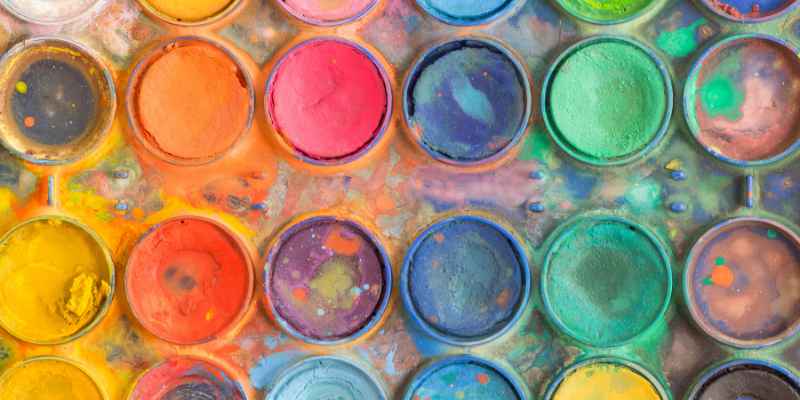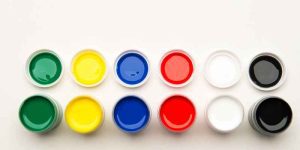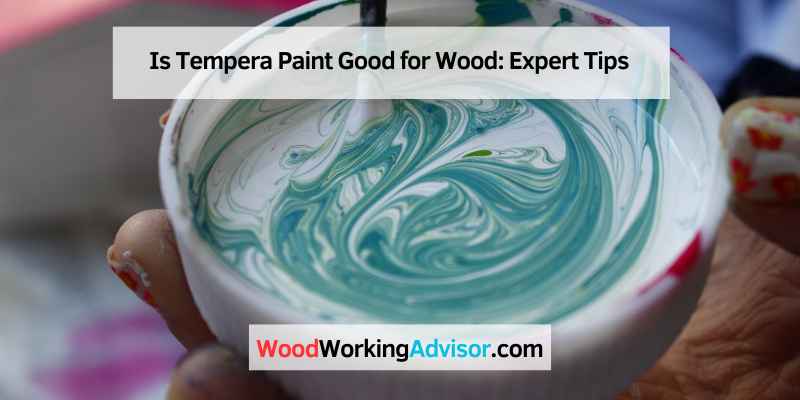Yes, tempera paint can be used on wood, especially on clean, unfinished, smooth wood surfaces. If the wood is slightly rough, a light sanding can be done to ensure better adhesion.
Tempera paint is a water-based paint that works well on porous surfaces like wood. It dries quickly and is less prone to cracking on solid wooden surfaces. It is important to note that tempera paint is not water-resistant or very resilient, so it is best suited for indoor wood objects.
Acrylic paint, on the other hand, is oil-based and works better on non-porous materials like glass or metal and dries to a glossy finish.
Understanding Tempera Paint
Tempera paint can be used on wood, especially on clean, unfinished, smooth surfaces. A light sanding may be required if the wood is slightly rough. It is best suited for solid wooden surfaces, as it dries quickly and is less prone to cracking.
Tempera paint is a water-based paint that has been used for centuries in various art forms. It consists of pigment mixed with a water-soluble binder, usually egg yolk or another type of glue, such as rabbit skin glue. This combination creates a versatile medium that can be applied to a wide range of surfaces, including wood.
Benefits of Using Tempera Paint
1. Easy application: One of the primary advantages of tempera paint is its ease of application. It glides smoothly onto the surface, allowing for precise details and clean lines. Even beginners can achieve beautiful results with this type of paint.
2. Vibrant colors: Tempera paint is known for its vibrant and opaque colors. The pigments used in tempera are finely ground, which gives them a rich and saturated appearance. This makes tempera paint especially suitable for creating bold and eye-catching designs on wood.
3. Quick drying time: Tempera paint dries quickly, typically within minutes of application. This allows artists to work efficiently and build up multiple layers without much waiting time. It also reduces the risk of smudging or accidental blending of colors.
4. Suitable for wood: Tempera paint adheres well to wood surfaces, making it a popular choice for painting on this material. It provides good coverage and can be used on both finished and unfinished wood. If the wood is rough, a light sanding can help create a smoother surface for painting.
Disadvantages of Using Tempera Paint
1. Limited water-resistance: Tempera paint is not highly water-resistant. It can be easily damaged or washed away when exposed to moisture. Therefore, it is not recommended for use on items that will be exposed to the elements or require regular cleaning.
2. Less durability: Compared to oil or acrylic paint, tempera paint is less durable and more prone to cracking or flaking over time. This makes it less suitable for long-lasting outdoor projects or high-traffic areas.
3. Limited flexibility: Unlike some other types of paint, tempera has limited flexibility when dry. This means it may crack or chip if applied to a surface that undergoes frequent movement or bending, such as wooden furniture.
In conclusion, tempera paint can be a good option for painting on wood, thanks to its easy application, vibrant colors, and quick drying time. However, it has some limitations, such as limited water-resistance, reduced durability, and limited flexibility. Therefore, it is important to consider the specific requirements of your project before deciding to use tempera paint on wood.
Using Tempera Paint On Wood
Tempera paint can be used on wood, especially on clean, unfinished, and smooth surfaces. It’s important to sand out any rough or splintery areas before painting. Tempera dries quickly, making it a suitable choice for wooden surfaces, and artists may need to add water as they work to prevent cracking.
Preparation Of Wood Surface
Before applying tempera paint on wood, it is crucial to prepare the wood surface adequately. Here are the essential steps:
- Clean the wood surface thoroughly to remove dirt, dust, and any existing paint.
- If the wood surface is rough, lightly sand it to smoothen out any imperfections.
- Ensure the wood is dry and free from moisture to prevent paint adhesion issues.
Applying Tempera Paint On Wood
When applying tempera paint on wood, follow these steps for optimal results:
- Start with a primer to improve paint adhesion and enhance color vibrancy.
- Apply the tempera paint using smooth, even strokes to achieve a uniform finish.
- Allow the paint to dry completely between coats to prevent smudging or blending of colors.
- Once the painting is complete, seal the surface with a protective coating to enhance durability.
Comparison With Other Paints

When deciding on the best paint for your wood projects, understanding the differences between tempera paint and other popular options can help you make an informed choice.
Tempera Vs. Acrylic Paint
Tempera Paint: Ideal for porous surfaces like wood, tempera offers a matte finish, making it suitable for indoor wood projects. While it may lack water-resistance, it can be a great choice for decorative pieces.
Acrylic Paint: Being oil-based, acrylic paint is better suited for non-porous surfaces such as metal or glass. It dries to a glossy finish, providing a durable and water-resistant coating for outdoor wood projects.
Tempera Vs. Oil-based Paint
Tempera Paint: Due to its fast-drying nature, tempera is often preferred for wooden surfaces to prevent cracking, especially on solid wooden surfaces. It may require light sanding on slightly rough wood for better adhesion.
Oil-Based Paint: Known for its superior coverage and opacity, oil-based paint is a popular choice for wood due to its durability and weather-resistance. However, it may take longer to dry compared to tempera paint.
Suitable Surfaces For Tempera Paint
The suitable surfaces for tempera paint are crucial to achieving the best results in your artwork. When it comes to using tempera paint on wood, there are a few factors to consider. Firstly, it is important to choose clean, unfinished, and smooth wood for the best adherence of the paint. If the wood surface is slightly rough, a light sanding can be done to ensure a smoother finish. While it doesn’t have to be perfectly smooth, any noticeable rough or splintery areas should be sanded out.
Porous Vs. Non-porous Surfaces
Tempera paint is primarily a water-based paint and is well-suited for porous surfaces like wood, paper, fabric, and canvas. Its ability to adhere and soak into these materials allows for vibrant color saturation and a matte finish. On the other hand, tempera paint may not work as effectively on non-porous surfaces such as glass or metal.
Common Surfaces For Tempera Painting
Tempera paint is widely used on various surfaces, making it a versatile medium for different art projects. Some of the common surfaces include:
- Canvas: The woven fabric provides a stable base for tempera paint, allowing for smooth brushstrokes and fine details.
- Wood: Unfinished, smooth wood surfaces provide a suitable texture for tempera paint. Whether it’s painting on panels or wooden objects, tempera can adhere well and create beautiful artwork.
- Fabric: Tempera paint can be used on fabric materials, making it a popular choice for creating vibrant designs on t-shirts, canvas bags, or other textile projects.
- Paper: One of the most common surfaces for tempera painting is paper. Whether it’s regular paper, watercolor paper, or even poster board, tempera paint can provide excellent coverage and vibrant colors.
- Paper mache: The absorbent nature of paper mache makes it an ideal surface for tempera paint. Artists often use tempera to decorate papier-mache sculptures or crafts.
Overall, tempera paint works well on porous surfaces like wood, paper, fabric, and canvas. It allows for vibrant color saturation and provides a matte finish to your artwork. So, if you’re looking to paint on wood, tempera paint can be a great choice, as long as you prepare the surface properly and ensure it is clean and smooth.
Expert Tips For Using Tempera Paint On Wood
Enhancing Water Resistance
When it comes to using tempera paint on wood, enhancing its water resistance is crucial for long-lasting results. To improve water resistance, consider adding a sealant to the painted wood surface. A clear polyurethane sealant can effectively protect the tempera paint from moisture, preventing it from deteriorating over time.
Choosing The Right Finish
Choosing the right finish for your tempera-painted wood can significantly impact its overall appearance and durability. For a sleek and protective finish, opt for a gloss or semi-gloss sealant. Conversely, a matte finish provides a more subtle appearance while still offering protection against moisture and wear.
Historical Significance Of Tempera Paint On Wood
In traditional art practices, tempera paint played a significant role in wood painting, particularly during the medieval and Renaissance periods. It was widely favored by artists for its vibrant color, durability, and ability to adhere well to wooden surfaces.
Tempera paint was chosen for wood painting due to its quick-drying nature, which reduced the risk of cracking on solid wooden surfaces. Additionally, it provided enhanced coverage and opacity, making it suitable for creating intricate details and rich color effects on wood. Its compatibility with wooden surfaces made it a preferred medium for creating long-lasting artworks.
Modern Applications
Tempera paint can be used on wood, particularly unfinished and smooth surfaces. Light sanding may be required for slightly rough wood. It is important to note that tempera paint is not water-resistant or very resilient, so it is best suited for indoor use on wood objects.
tempera paint, once known as a traditional medium used for religious art and historic paintings, has now found modern applications in contemporary art. Artists today are exploring new ways to incorporate tempera paint into their work, and one such application is using it on wood surfaces.
Tempera Paint In Contemporary Art
In the world of contemporary art, artists are constantly pushing boundaries and experimenting with different materials. One such material is wood, which provides a unique and organic canvas for artistic expression. Tempera paint, with its rich history and vibrant pigments, is being used by artists to create stunning works of art on wood.
Using tempera paint on wood allows artists to achieve various effects, from bold and opaque colors to delicate and translucent layers. The versatility of tempera paint makes it an ideal choice for artists who want to create intricate details and textures on their wooden surfaces.
Challenges In Using Tempera On Wood
While tempera paint can bring life to wood surfaces, there are a few challenges that artists may face. One challenge is the preparation of the wood itself. If the wood is rough or splintery, a light sanding may be necessary to create a smooth surface for the paint to adhere to. However, it’s important to note that the wood doesn’t have to be perfectly smooth for tempera paint to be applied effectively.
Another challenge is the drying time of tempera paint. Unlike other types of paint, tempera paint dries quickly, which means that artists have to work fast and continuously add water as they go. This can be especially challenging when working on wood, as the absorption properties of the material can affect how the paint behaves. However, with practice and experimentation, artists can overcome these challenges and achieve stunning results.
To summarize, tempera paint has found a place in contemporary art, particularly when it comes to painting on wood surfaces. While there may be challenges involved, artists are embracing the unique qualities of tempera paint and using it to create captivating works of art on wood.
Exploring Alternative Painting Techniques
Exploring various techniques for painting on wood can lead to unique and visually appealing results. While tempera paint is a popular choice, alternative methods like acrylic painting and oil-based paints offer different textures and finishes.
Acrylic Painting On Wood
Acrylic paints provide a versatile option for wood surfaces due to their quick drying time and durability. One can achieve vibrant colors and a glossy finish with acrylics, making them a preferred choice for many artists.
Using Oil-based Paints On Wood
Oil-based paints offer a rich and lustrous finish on wood, allowing for blending and layering colors with ease. While they require longer drying times, the smooth and glossy appearance they provide is worth the wait.

Frequently Asked Questions Of Is Tempera Paint Good For Wood
Can You Paint Tempera On Wood?
Tempera paint can be used on wood, especially on clean, smooth surfaces with light sanding if needed.
What Is The Disadvantage Of Tempera Paint?
The disadvantage of tempera paint is its thin layers, which result in less coverage and opacity compared to oil paint.
Why Was Tempera Paint Used On Wood?
Tempera paint is used on wood because it dries quickly and works well on solid wooden surfaces without cracking. It is ideal for porous materials like wood and provides a matte finish.
Is Tempura Or Acrylic Paint Better For Wood?
For wood, acrylic paint is better than tempera paint because it is oil-based and works well on non-porous materials. Acrylic paint provides a glossy finish and is more resilient than tempera paint, which dries to a matte finish and is not water-resistant.
Conclusion
Tempera paint can be used on wood, especially if the wood is clean, unfinished, and smooth. If the wood is rough, a light sanding can help create a better surface for the paint. Keep in mind that tempera paint is not water-resistant or very resilient, so it is best suited for indoor wood objects.
Acrylic paint, on the other hand, is more suitable for non-porous materials like glass or metal. Consider the finish you desire, as tempera paint dries to a matte finish while acrylic paints dry to a glossy finish. Ultimately, the choice between tempera and acrylic paint depends on your specific needs and preferences.


